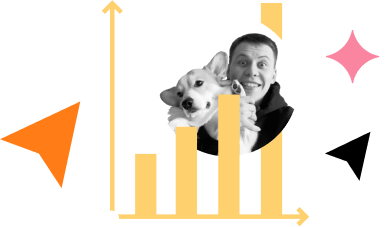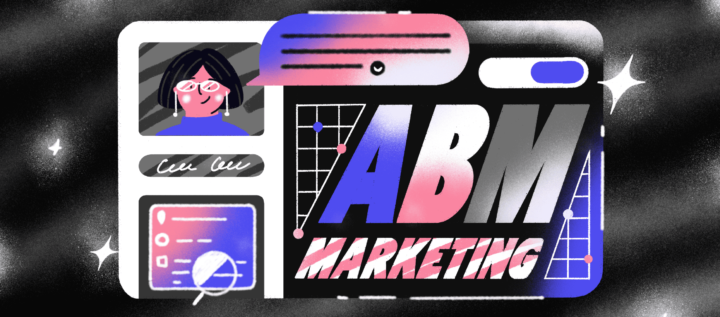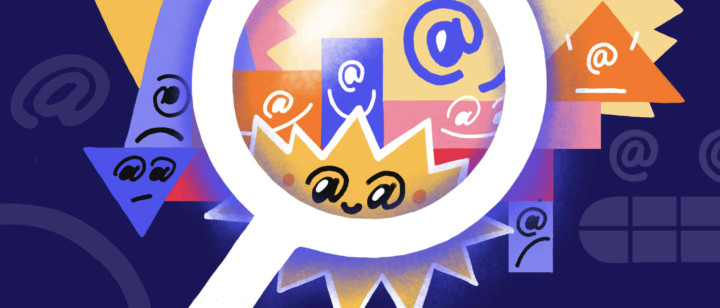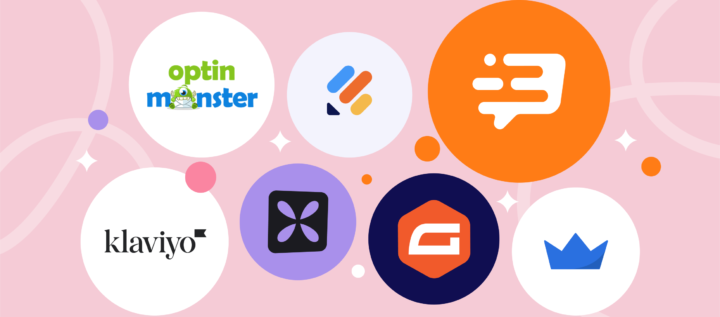How to establish the lead qualification process in sales and marketing teams

If you’re a marketer, it’s highly likely that one of your major KPIs is the number of leads collected. But you must not forget about the quality of leads in pursuit of them.
You need a well-established qualification process in sales and marketing teams to only work with those who are actually willing to buy your product and really need it.
In this guide, we’ll tell you what the qualification is, why it is important to qualify users; we’ll guide you through the qualification funnel and tell you how to qualify leads using a chatbot.
What is the lead qualification?
Lead qualification is a systematic process of evaluating potential customers by their ability, readiness, and willingness to buy your product or service.
The process includes the assessment of the lead’s need for your product, their ability to make a purchase, and the amount of money required to make a payment.
You need the lead qualification to define who is actually interested in buying your product among the leads you’ve collected, who has all the required opportunities to do that, and who was just passing by.
Defining the customer potential allows you to communicate with users more selectively, reducing the time it takes from becoming familiar with the product to buying it later, and to segment leads in the future, and establish a more personalized communication.
Why do you need to qualify leads?
The sooner you start to qualify your leads, the more necessary information you’ll have on your hands. And this information, in turn, will help you select users and communicate with them in a new fashion: you’ll know beforehand what they are interested in, what tasks and issues they have.
Lead qualification helps the sales team save their time and increases the number of successful deals, and it also helps determine:
- if a potential customer experiences an issue that your product can solve;
- in what industry a potential customer is working and if they can get most benefits from the product;
- if your potential customer has enough money and authority to make a decision on buying the product;
- if you can demonstrate a greater value of your product compared to a competing solution that a potential customer is using at the moment.
An account specialist usually spends from 15 minutes to an hour on communicating with an incoming lead and getting a brief from them, though not every lead is a target one
Tammy, Managing Director at Rick.ai
Imagine that the marketing team collected a thousand emails and handed them over to the sales time. Will the communication with the received leads be effective?
- The sales team will spend time to process all emails;
- Communication via email will not bring any results.
So, what to do? The most important thing is to remember that the quality of the collected leads comes first over quantity, and the more information you gather on a user, the better.

Three levels of user qualification
Lead qualification begins when a user makes some action on a website, for example, they first enter a website, text you in a chat, place an order, leave their data in a lead form or sign up to your product.
There’s a proper funnel of the lead qualification process that a user is going through as they leave their contact info:

The first stage of the qualification is carried out by the marketing team with the help of a qualifying chatbot or registration forms and lead magnets on the website and in the blog.
The second stage of the qualification: the marketing team is scoring the leads (Lead Scoring) and handing the “most valuable” to the sales team, and keeps nurturing the rest of the leads (Lead Nurturing).
The third stage of the qualification: the sales team contacts a lead having the user information gathered by the marketing team on their hands (user’s workplace, the company website, or data on the products viewed) and carries out a deeper qualification — that is, defines an issue, the level of interest in buying a product, and the budget, and then selects the most appropriate solution.
During communication, sales reps gather even more useful information and learn about the needs and challenges of the user, as well as their decision-making area and opportunities.
We can distinguish three types of leads depending on which team is dealing with them:
- Marketing Qualified Leads;
- Sales Accepted leads;
- Sales Qualified Leads.
Marketing Qualified Leads (MQLs)
MQLs are the ones gathered and qualified by the marketing team via various content, lead magnets, and email subscriptions.
Sales reps spend 70% of their time on non-target leads. Therefore, lead qualification on the marketing team side is important
Nick, Marketer at IIDF
Marketing qualified leads have already shown interest in your product and understand what you are doing.
At this stage of the customer journey, the marketing team initially qualifies users through email, live chat, or chatbot and selects those who can be handed over to the sales team and those who still need to be nurtured.
How do you know that a user is ready to buy from you? Using lead scoring, the marketing team can group leads in particular segments depending on their actions on a website.
If we see that a user is reading our blog daily, downloading our checklists, and reading emails from us, it is highly likely that they are prepared for further communication with the sales team.
Depending on the user’s level of interest and their qualification by the marketing team, they are either marked as not ready to purchase right now or handed over to the sales team.
Sales Accepted Leads (SALs)
Sales accepted leads are users qualified by the marketing team and handed over to the sales team for further research and qualification.
Let’s imagine you’re a digital agency offering a free website audit to your potential customers.
Everyone who agreed to take part in the audit was qualified by the marketing team, and now their contact details are handed over to the sales team for further qualification.
Read also:
👉 Live Chat Best Practices: 20 Hacks to Make Customer Service Better
👉7 Best Live Chat for eCommerce: Boost Conversion on your Website
👉 Top 5 live chat mobile app: find the best fit for your business
👉 Live Chat: How Online Chat Tool Can Help Your Business
👉 20 Best Live Chat Software for your website chat service
👉 Acquisition funnel marketing: Grow customer conversions at each step of user journey
👉 The top 15 inbound marketing tools: harness digital power and elevate your business
👉 10 best website personalization tools to deliver top-notch visitors experience
👉 7 best email capture tools: features and pricing compared for 2024
Sales Qualified Leads (SQLs)
Sales qualified leads are practically ready to purchase.
At this stage, the sales team should define the needs, challenges, and opportunities of the user to be able to make them an advantageous offer and close the deal.
Suppose the marketing team handed over a lead with a phone number, company name, its size, and a website to the sales team. A sales rep is now preparing for a phone call and conducts a preliminary user analysis, namely: becomes familiar with their website and selects the solution.
When a sales rep calls a user, they already have all the necessary information on their hands for the conversation. All is left is to obtain more insights into the customer’s challenges and offer a suitable solution. There are several qualification models that can help you define if a customer suits you or not.
Lead qualification models
Sales teams need qualification models to define customer issues, that is, what they want to obtain using your solution, how much they need it, and whether they have purchasing opportunities.
Each of the models is based on several parameters listed below and prioritizes them in different ways:
- customer budget (Budget / Money);
- customer authority within a company (Authority);
- the need to purchase (Need);
- Plans;
- Timing / Urgency;
- Prioritization.
Depending on the type and features of your company, you are to define on your own which model suits you better and arrange qualification interviews in the sales team based on the selected model.
The advantage of these models is that the sales team has a clear framework for user research and defining their interest in making a purchase.
BANT
BANT (Budget, Authority, Need, Timing) is one of the most popular qualification frameworks; it has been and still is being applied by very different companies. Using this framework, you can draw up a rather comprehensive view of a potential customer.
In this framework, the potential customer’s budget is a major qualification parameter, and all other criteria come next.
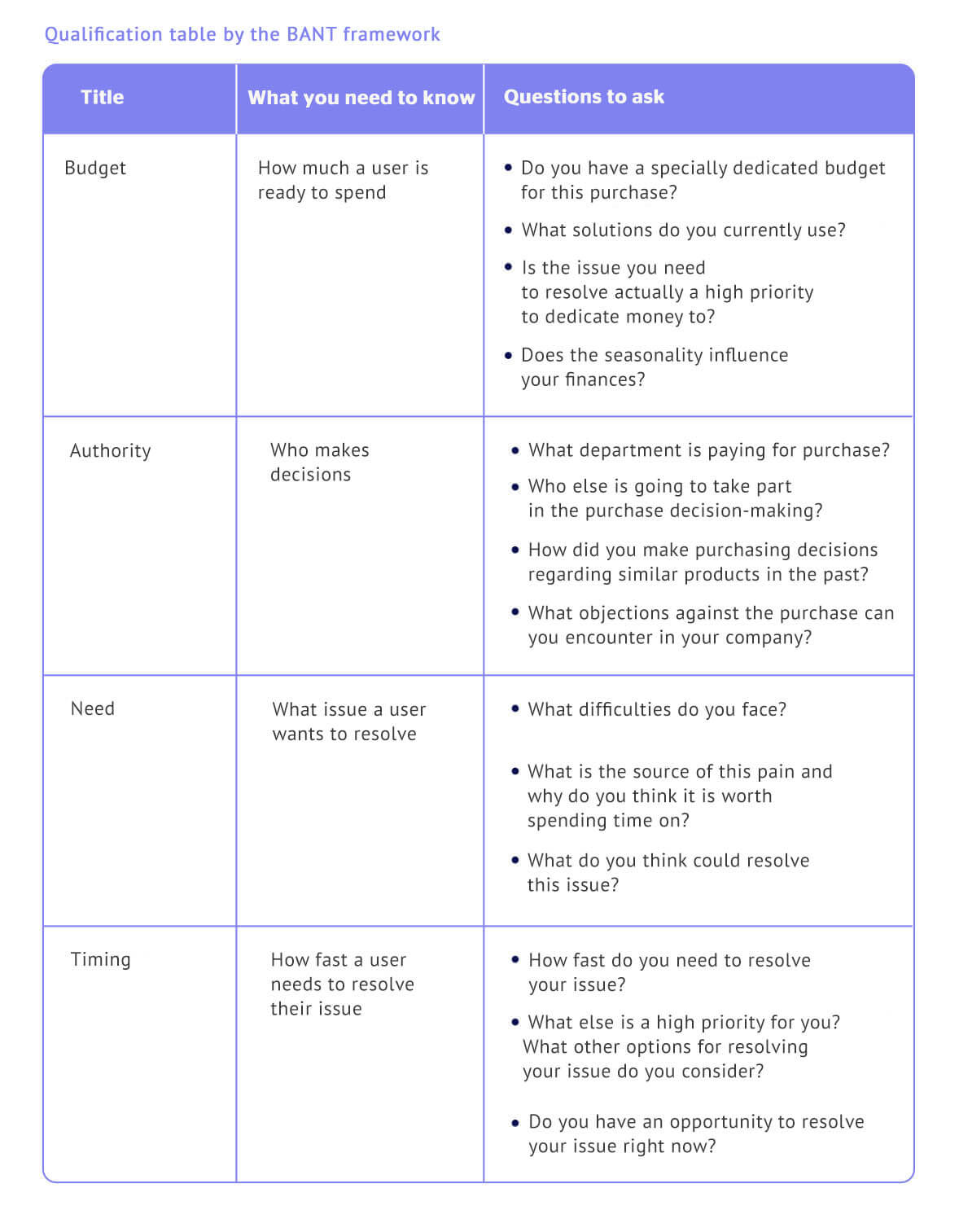
Many sales experts note that the BANT framework underestimates the need of a customer for a purchase assuming that this is less important than their budget and authority. Therefore, let’s examine another model.
GPCTBA/C&I
The GPCTBA / C&I (Goals, Plans, Challenges, Timeline, Budget, Authority, Negative Consequences, and Positive Implications) framework allows dedicating more time to the features of your customer, their issues, and plans.
The advantage of this model is that it allows the sales team to gather lots of information on a potential customer and not just find out their available purchasing budget, but dive deeply into the customer’s world and understand their pains.
If you offer a complex product, getting these insights will be priceless.
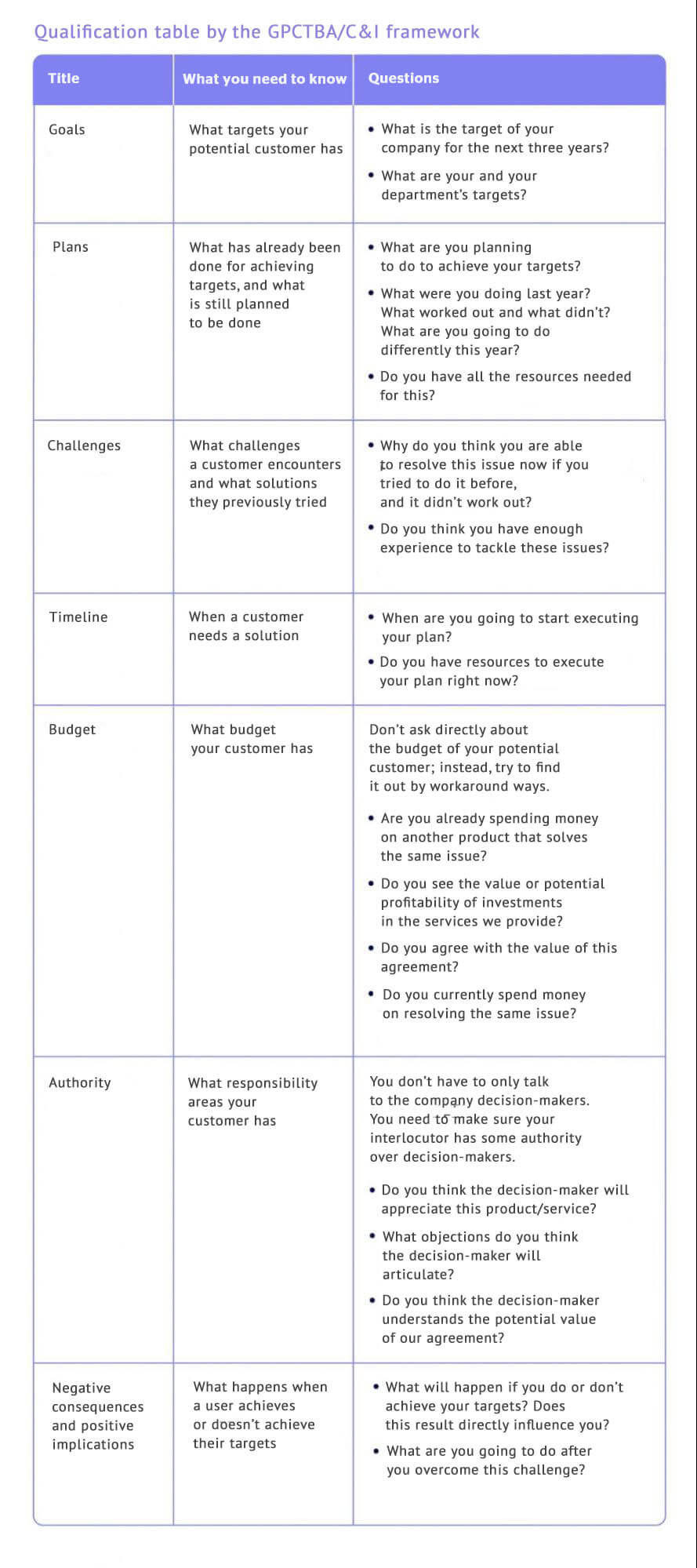
There are also other models. They basically duplicate each other and use the same parameters, and their major difference is in different priorities: within the ANUM (Authority, Need, Urgency, Money) framework, the major indicators are the customer’s authority and responsibility areas, and in the CHAMP (Challenges, Authority, Money, and Prioritization) framework, the most important component is how big the customer’s issue is.
The choice of a model depends on the features of your business, its size, and the target audience. You can also define which parameters are more important to you and compile your proper model based on these indicators.
In the second part of this article, we’ll turn to the qualification in practice and tell you how to qualify users at every stage of the funnel.
Free expert insights to boost your marketing strategy and raise conversion to a target action by 10%
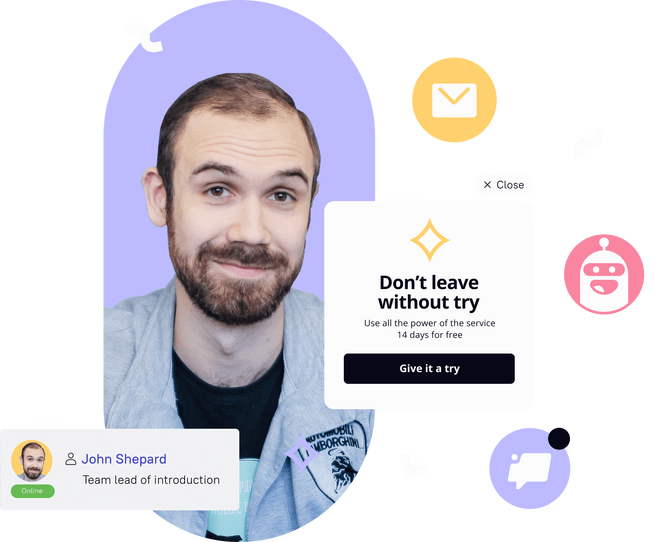
More on lead generation:
You can automate the process of lead generation and scoring with a chatbot. Learn more about it in our video:
Read also:
- The best way to collect emails: 5 top-notch methods unveiled
- 3-step guide on inbound lead qualification: how to qualify inbound leads on autopilot
- Choose your ideal lead nurturing platform: Top 10 software tested by experts
- Top 12 lead qualification tools to deliver your sales hot leads only
- Top 10 customer segmentation tools to personalize customer communications
